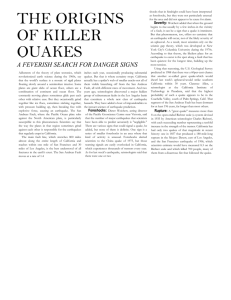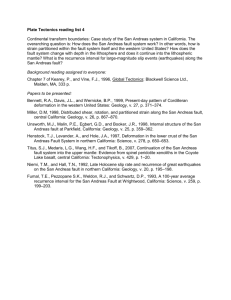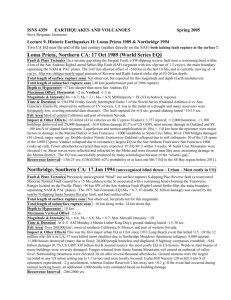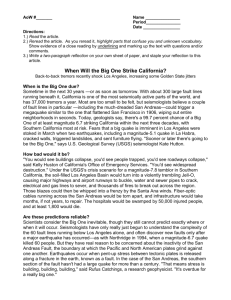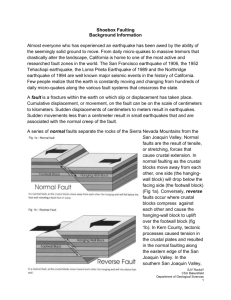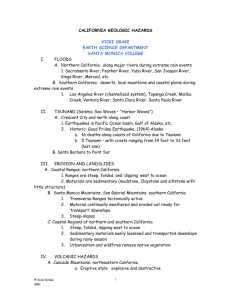Part B, CSP – San Francisco to San Juan Bautista
advertisement
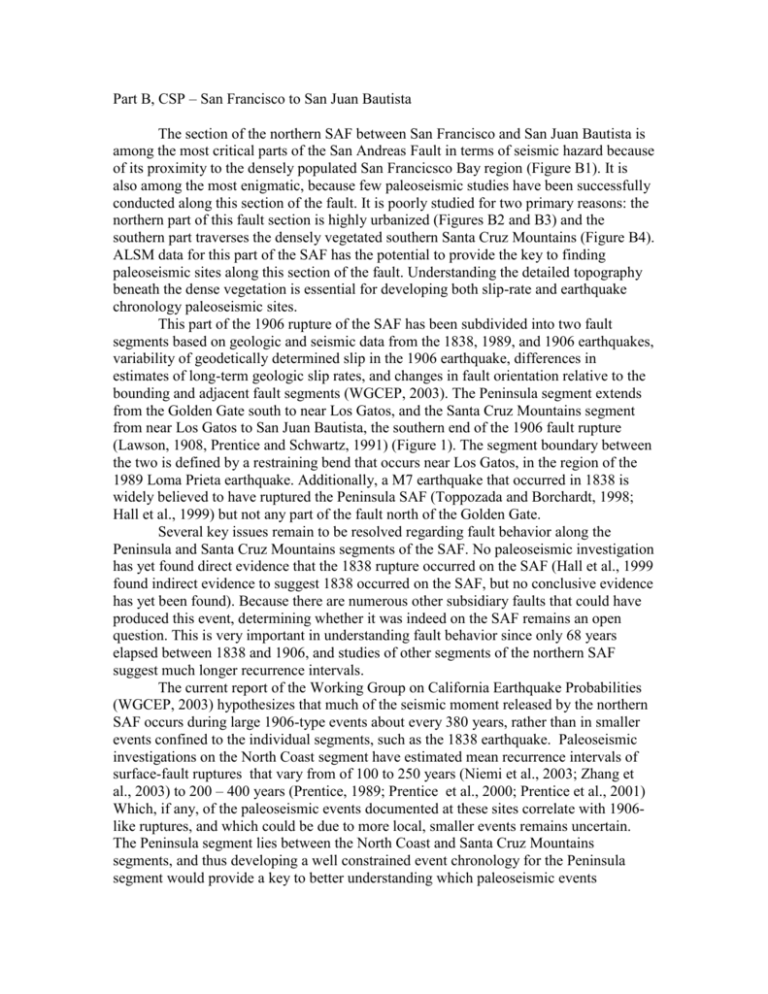
Part B, CSP – San Francisco to San Juan Bautista The section of the northern SAF between San Francisco and San Juan Bautista is among the most critical parts of the San Andreas Fault in terms of seismic hazard because of its proximity to the densely populated San Francicsco Bay region (Figure B1). It is also among the most enigmatic, because few paleoseismic studies have been successfully conducted along this section of the fault. It is poorly studied for two primary reasons: the northern part of this fault section is highly urbanized (Figures B2 and B3) and the southern part traverses the densely vegetated southern Santa Cruz Mountains (Figure B4). ALSM data for this part of the SAF has the potential to provide the key to finding paleoseismic sites along this section of the fault. Understanding the detailed topography beneath the dense vegetation is essential for developing both slip-rate and earthquake chronology paleoseismic sites. This part of the 1906 rupture of the SAF has been subdivided into two fault segments based on geologic and seismic data from the 1838, 1989, and 1906 earthquakes, variability of geodetically determined slip in the 1906 earthquake, differences in estimates of long-term geologic slip rates, and changes in fault orientation relative to the bounding and adjacent fault segments (WGCEP, 2003). The Peninsula segment extends from the Golden Gate south to near Los Gatos, and the Santa Cruz Mountains segment from near Los Gatos to San Juan Bautista, the southern end of the 1906 fault rupture (Lawson, 1908, Prentice and Schwartz, 1991) (Figure 1). The segment boundary between the two is defined by a restraining bend that occurs near Los Gatos, in the region of the 1989 Loma Prieta earthquake. Additionally, a M7 earthquake that occurred in 1838 is widely believed to have ruptured the Peninsula SAF (Toppozada and Borchardt, 1998; Hall et al., 1999) but not any part of the fault north of the Golden Gate. Several key issues remain to be resolved regarding fault behavior along the Peninsula and Santa Cruz Mountains segments of the SAF. No paleoseismic investigation has yet found direct evidence that the 1838 rupture occurred on the SAF (Hall et al., 1999 found indirect evidence to suggest 1838 occurred on the SAF, but no conclusive evidence has yet been found). Because there are numerous other subsidiary faults that could have produced this event, determining whether it was indeed on the SAF remains an open question. This is very important in understanding fault behavior since only 68 years elapsed between 1838 and 1906, and studies of other segments of the northern SAF suggest much longer recurrence intervals. The current report of the Working Group on California Earthquake Probabilities (WGCEP, 2003) hypothesizes that much of the seismic moment released by the northern SAF occurs during large 1906-type events about every 380 years, rather than in smaller events confined to the individual segments, such as the 1838 earthquake. Paleoseismic investigations on the North Coast segment have estimated mean recurrence intervals of surface-fault ruptures that vary from of 100 to 250 years (Niemi et al., 2003; Zhang et al., 2003) to 200 – 400 years (Prentice, 1989; Prentice et al., 2000; Prentice et al., 2001) Which, if any, of the paleoseismic events documented at these sites correlate with 1906like ruptures, and which could be due to more local, smaller events remains uncertain. The Peninsula segment lies between the North Coast and Santa Cruz Mountains segments, and thus developing a well constrained event chronology for the Peninsula segment would provide a key to better understanding which paleoseismic events documented on the North Coast may have extended through to the Santa Cruz Mountains segment. Paleoseismic studies along the North Coast segment suggest large earthquakes occur typically every few hundred years (Prentice, 1989, Knudsen et al., 2002), implying much different behavior than along the Peninsula SAF, if the 1838 event was produced by the SAF. Findings from recent detailed paleoseismic studies on the Santa Cruz Mountains segment (Fumal et al., 2003) suggest that large magnitude surface-rupturing earthquakes may be more frequent on individual fault segments comprising the northern San Andreas fault than are ruptures of the entire 1906 segment. No information is available about earthquakes prior to 1838 along the Peninsula segment, and only one site along the Santa Cruz Mountains segment has provided information about events prior to the penultimate earthquake (Fumal et al., 2003). Because this site is near the northern end of the creeping section, it is possible that, like the Parkfield segment immediately south of the creeping zone, this section of the fault may produce more frequent smaller events than occur along the other segments of the northern SAF. How often 1906-type ruptures occur and whether smaller earthquakes rupture individual segments more frequently is of crucial importance to San Francisco Bay area seismic hazard. Finding viable additional paleoseismic sites along the Peninsula and Santa Cruz Mountains fault segments is critical to advancing the understanding of fault behavior and seismic hazard. ALSM data has the potential to reveal paleoseismic sites that can be developed to advance our understanding of the northern SAF. In addition to questions about earthquake paleo-chronologies, significant questions remain about the slip rate along the northern SAF. In particular, Hall et al. (1999) propose that the slip rate along the fault is significantly lower south of the Golden Gate (17 mm/yr south of the Golden Gate versus 24 mm/yr north of the Golden Gate). However, more recent studies suggest the difference north and south of the Golden Gate may be negligible (Prentice et al., 2001). Only one long-term slip rate site has provided well-constrained long-term slip information on the Peninsula segment (Hall et al., 1999) and little long-term slip-rate data are available anywhere else along the SAF south of the Golden Gate. ALSM data also has the potential to reveal paleoseismic sites that can be developed to advance our understanding of the slip rate of the northern SAF. Figure B1: Location with fault and segments and SF SJB Los Gatos locations of B2, Figure B2: ‘46 air photo ‘89 air photo Figure B3: 1906 fence offset suite Figure B4: Sta Cruz Mtns aerial view References Fumal, T.E., Dawson, T.E., Flowers, R., Hamilton, J.C., Kessler, J., Samrad, L., Heingartner, G.F., Reidy, L.M., Seitz, G. and Southon, J., 2003, A 100-yr average recurrence interval for the San Andreas fault, southern San Francisco Bay area, abs., First Annual Northern California Earthquake Hazards Workshop, January 13-14, 2004, held at the U.S. Geological Survey, Menlo Park, California. Goldfinger, C., Nelson, C., Johnson, J., and Ericsson, A., 2003, Determining the ages and origin of earthquake triggered submarine landslides, abs, American Geophysical Union, EOS Transactions, 84 (46), p. F819. Hall, N.T., Wright, R.H., and Clahan, K.B., 1999, Paleoseismic studies of the San Francisco peninsular segment of the San Andreas fault zone near Woodside, California: Journal of Geophysical Research, v. 104, no. B10, p. 23,215-23,236. Hall, N.T., Wright, R.H., and, C.S. Prentice, 2001, Studies along the peninsula segment of the San Andreas fault, San Mateo and Santa Clara Counties, California: author Ferriz, H. and Anderson, R., in Engineering Geology Practice in Northern California, CDMG Bulletin 210, p. 193 to 210. Knudsen, K.L. Witter, R.C., Garrison-Laney, C.E., Baldwin, J.N., and Carver, G.A., 2002, Past Earthquake-Induced Rapid Subsidence Along the Northern San Andreas Fault: A Paleoseismological Method for Strike-Slip Faults, Bulletin of Seismological Society of America. Vol. 92, no. 7, p. 2,612-2,636. Lawson, A. C., 1908, The California earthquake of April 18, 1906, Report of the State Earthquake Investigation Commission, Carnegie Institute of Washington. Muhs, D.R., Prentice, C.S., and Merritts, D.J., 2003, Marine terraces, sea level history and Quaternary tectonics of the San Andreas fault on the coast of California, in: Easterbrook. D.J., editor, Quaternary Geology of the United States, INQUA 2003 Field Guide Volume, Desert Research Institute, Reno, NV, p. 1-18. Niemi, T., 2003, Zhang, H., and Generaux, S., 2003, Determination of a high resolution paleoearthquake chronology for the northern San Andreas fault at the Vedanta marsh site, Marin County, CA, Annual Project Summary for USGS NEHRP Award No. 03HQGR0015. Prentice, C.S. Langridge, R., and Merritts, D J., 2000, Paleoseismic and Quaternary tectonic studies of the San Andreas fault from Shelter Cove to Fort Ross [abs.], in: Bokelmann, G. and Kovach, R.L., eds.: Proceedings of the Third Conference on Tectonic Problems of the San Andreas System, Stanford University Publications, p.349-350. Prentice, C.S., Langridge, R., Baldwin, J.N., Dawson, T., Merritts, D.J., and Crosby, C.J., 2001, Paleoseismic and Quaternary tectonic studies of the San Andreas Fault between Shelter Cove and Fort Ross, Northern California, USA [abs]: Ten Years of Paeoseismology in the ILP: Progress and Prospects, 17-21 December, 2001, Kaikoura, New Zealand, Programme and Abstracts. Institute of Geological and Nuclear Sciences Information Series 50, p. 52-53 Prentice, C. S., and Schwartz, D. P., 1991, Re-evaluation of 1906 surface faulting, geomorphic expression, and seismic hazard along the San Andreas fault in the southern Santa Cruz Mountains: Bulletin of the Seismological Society of America, v. 81, no. 5, p. 1424-1479. Prentice, C.S., 1989, Earthquake geology of the northern San Andreas fault near Point Arena, California: Pasadena, California, California Institute of Technology, Ph.D. Dissertation, 252 p. Schwartz, D.P., Pantosti, D., Okumura, K., Powers, T.J., and Hamilton, J., 1998, Paleoseismic investigations in the Santa Cruz mountains, California: Implications for recurrence of large-magnitude earthquakes on the San Andreas fault: Journal of Geophysical Research, v. 103, no. B8, p. 17,985-18001. Toppozada, T.R, and Borchardt, G., 1998, Re-evaluation of the 1836 “Hayward fault” and the 1838 San Andreas fault earthquakes, Bull. Seis. Soc. Am., v. 88, p. 140-159. Working Group on California Earthquake Probabilities, 2003, Earthquake probabilities in the San Francisco Bay Region: 2002 to 2031: U.S. Geological Survey Open-File Report 03-214. Zhang, H., Niemi, T., Generaux, S., and Fumal, T., 2003, Earthquake events and recurrence interval on the northern San Andreas fault at Vedanta marsh site, Olema, CA, abs. Geological Society of America, North-Central Meeting, 37th-Annual Meeting, March 2425, 2003.

